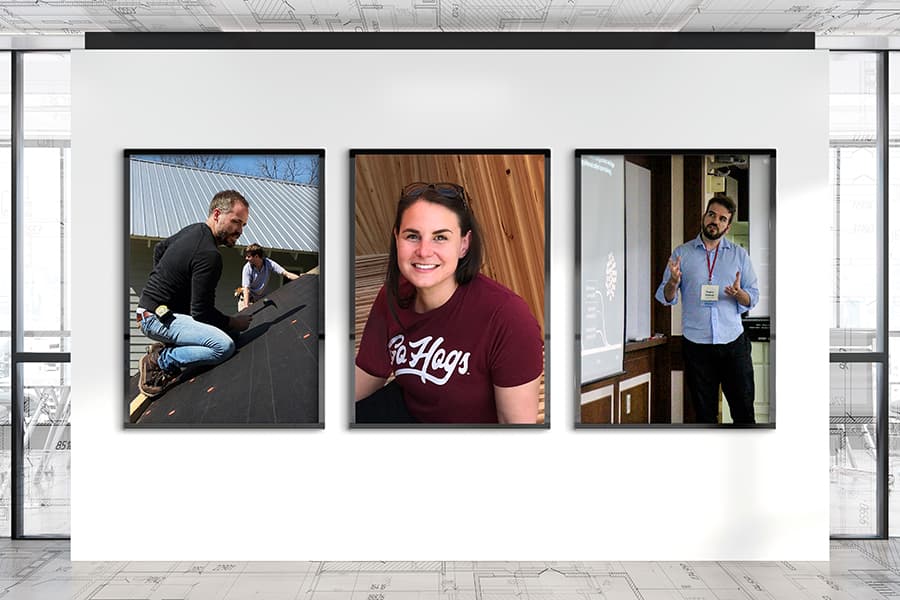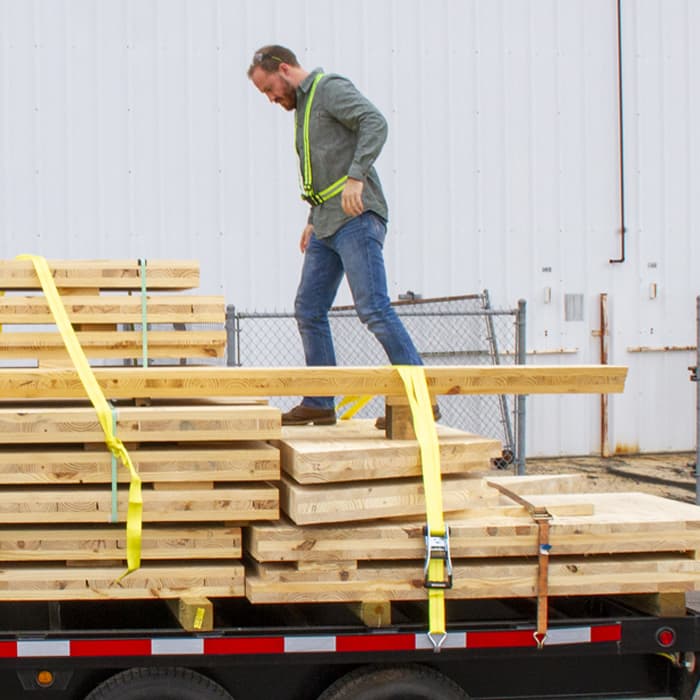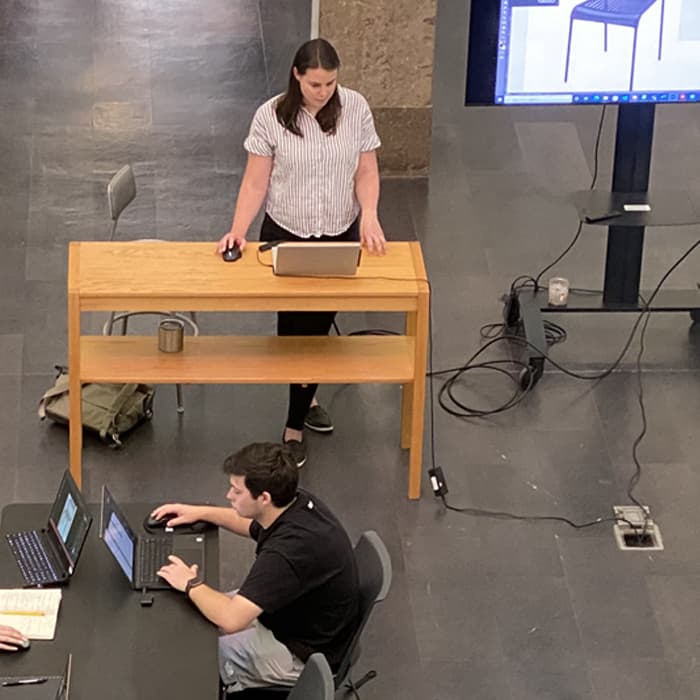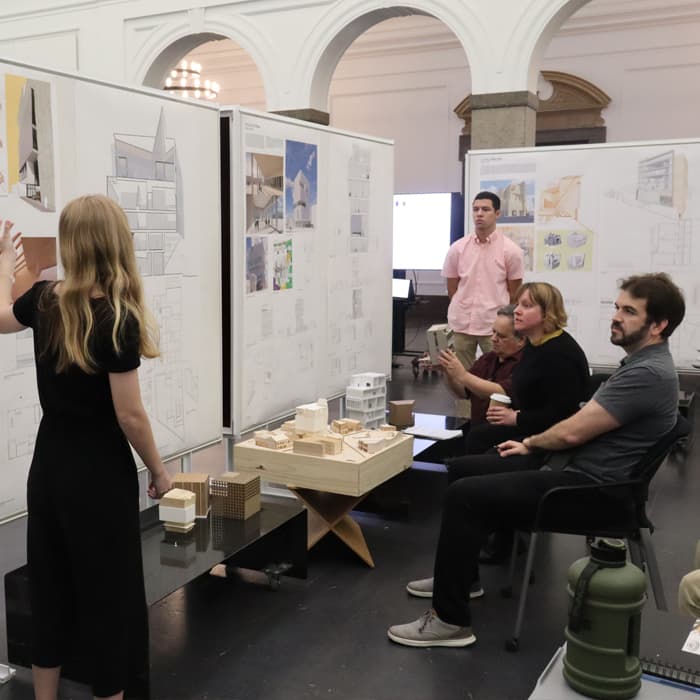
From Paws to Tusks
CMU alumni shape future architects as University of Arkansas faculty
A trio of Carnegie Mellon University alumni has added Razorback red to their CMU Tartan.
This fall, College of Fine Arts graduates David Kennedy and Alyssa Kuhns and soon-to-be graduate Pedro Veloso will start their second year teaching as professors at University of Arkansas’ Fay School of Architecture and Design.
“During my tenure at Carnegie Mellon, I was fortunate to have worked with each in different capacities,” says John Folan, head of Arkansas’ School of Architecture who maintains a courtesy appointment at CMU’s School of Architecture as founder and director of the Urban Design Build Studio and executive director of PROJECT RE_.
“While their individual areas of expertise and interest vary, they share similar characteristic sensibilities — each is solution-oriented, each maintains a curiosity that propels their creative effort, each is collaboratively minded, each an innovator, and each has their heart in the work.”
“I hope my students leave class with more unanswered questions than when they started. I hope they see the breadth of impact design can have, and they feel empowered to engage the profession in a critical way."
David Kennedy, Assistant professor
Fay Jones School of Architecture and Design, University of Arkansas
Trusting Your Instincts
When Pittsburgh native David Kennedy started his architecture studies at another university, he was assigned a text written by Douglas Cooper, CMU’s Andrew Mellon Professor of Architecture.
“At that moment, I thought ‘Maybe I should go straight to the source?,” says David, who graduated in 2010 with a bachelor’s degree in architecture. “I made up my mind to transfer in about two weeks. I applied, got accepted and didn’t look back!”
He studied with Douglas, even assisting him with some artwork, and learned to trust his creative instincts and find value in rigor.
“Those lessons have helped me succeed in a career defined by leaps of faith, and I hope to imbue the same in my students moving forward,” David says.
After CMU, David earned his master’s degree at Harvard University’s Graduate School of Design and was an assistant professor of architecture at Auburn University. While in graduate school, he co-founded Decentralized Design Lab, an architectural practice focused on matching availability of building resources with humanity’s need for shelter, and the firm's work continues today.
At Arkansas, he teaches building materials and assemblies, coordinates a core studio for third years in the undergraduate curriculum and assists with studio instruction on an Urban Design Build Studio project. The decision to join Arkansas’ faculty was an easy one that aligned with his passions and interests in research that focuses on the economic, ecological, social and energetic impacts of mass timber construction systems.
By teaching the next generations of architects, he aims to make a big difference in the industry.
“I hope my students leave class with more unanswered questions than when they started,” David says. “I hope they see the breadth of impact design can have, and they feel empowered to engage the profession in a critical way.”
In addition to these hopes that he also shares with fellow Tartan and fiancée Alyssa: He wants his students to be committed and dedicated to the work.
“Design is about problem-solving, and I want my students to leave my courses understanding how to become self-initiated problem-solvers. There is not always a correct answer or clear path to take, which means students need to trust a process built on testing, experimenting, and, sometimes, failing in order to make progress.”
Alyssa Kuhns, Assistant professor
Fay Jones School of Architecture and Design, University of Arkansas
The Power of Problem-Solving
For Alyssa Kuhns, her career path has always been human-centered.
“I was in awe of the intellect and undying passion many of my peers and faculty brought to the classroom and their own work at Carnegie Mellon,” says Alyssa, who grew up in Allentown, Pennsylvania, and graduated in 2010 with a bachelor’s degree in architecture.
“The people really made CMU feel like the right place for me.”
One of those people was John Folan. He showed her how Arkansas’ collaboration across disciplines to advance design research efforts, especially those focused on technological and material innovations, were a match for her and her research aims, which center on material culture’s impacts on the domestic realm.
At Arkansas, she coordinates a core studio for first years in the undergraduate curriculum, teaches design thinking and navigates the delicate balance of instruction versus exploration in her teaching.
“Design is about problem-solving, and I want my students to leave my courses understanding how to become self-initiated problem-solvers,” Alyssa says. “There is not always a correct answer or clear path to take, which means students need to trust a process built on testing, experimenting, and, sometimes, failing in order to make progress.”
After CMU, Alyssa worked as a project manager for a Massaro Corporation before receiving her master’s degree in industrial design at Pratt Institute. She was the inaugural interior architecture fellow at the University of Tennessee, Knoxville, and a visiting assistant professor of architecture at Auburn University.
Throughout her career and into her present-day classroom, she carries lessons from her time at Carnegie Mellon, including travel to Venice, Italy, and a summer in China.
“My experience at CMU taught me so much about the diversity of people, places and cultures,” Alyssa says. “Now, I often emphasize the importance of travel to students as a way to meet new people and understand relationships between a culture and the built environment.”
Brazilian-born and soon-to-be alumnus Pedro couldn’t agree more.
“I want them to learn how to integrate computational technology into different aspects of design, from the customization of building details to the analysis of urban and environmental data. I hope they critically rethink the structure of the design process, the conceptualization of architectural space and construction practices in the contemporary world.”
Pedro Veloso, ASSISTANT PROFESSOR
FAY JONES SCHOOL OF ARCHITECTURE AND DESIGN, UNIVERSITY OF ARKANSAS
Design + AI
Pedro Veloso has plotted his future with intention — an intention to learn and teach in educational institutions in different parts of the world after earning his bachelor’s degree in architecture and urbanism at the University of Brasilia and master’s degree in architectural design from the University of Sao Paulo.
“Being a foreigner is very challenging,” says Pedro, who this fall is defending his architecture doctoral dissertation in interactive generative design with a focus on deep learning and multi-agent reinforcement learning. “But it allows you to identify and learn about the different aspects of the local culture that are taken as givens.”
For him, these local aspects are evident in the different learning styles of these two institutions. As a CMU student he embraces creative, interactive and interdisciplinary research at the intersection of art, design and technology. At Arkansas, he focuses on the importance of design in construction and in contemporary architectural issues such as spatial justice and environmental responsibility.
“These are all strengths that I will use to ground my future pedagogy,” Pedro says. “Those are all important elements to build the strong background and confidence to properly identify and tackle unexplored and challenging problems.”
At CMU, he’s been immersed in the computational design program that combines artificial intelligence and architecture. The program takes a computer science view of design, applying both the science and art of computing to design problems.
He intends to imbue his students in his generative design and building systems integration courses and architectural design studios with his CMU program’s future-focused view.
“I want them to learn how to integrate computational technology into different aspects of design, from the customization of building details to the analysis of urban and environmental data,” Pedro says. “I hope they critically rethink the structure of the design process, the conceptualization of architectural space and construction practices in the contemporary world.”
As he grows in his academic and teaching career, Pedro will have his fellow Tartans to lean on.
“I really enjoy having Alyssa and David as my colleagues,” Pedro says. “We definitely share a similar pedagogical attitude, consisting of open-mindedness, strong work ethics and drive for experimentation and innovation.”
Fay Jones School of Architecture and Design at Arkansas Dean Peter MacKeith believes the school “benefits enormously” from David's, Alyssa's and Pedro’s talents.
“The arrival of these superb colleagues in the last four years has been transformative for the department and, indeed, for the school overall,” MacKeith says. “Carnegie Mellon University can take pride in the development of the faculty, and we are grateful for this recognition of them.”
Indeed, CMU School of Architecture Head Omar Khan echoed Peter’s sentiments about the trio.
"We couldn't be more proud of this group of alumni, whose exemplary work has led them to their current roles at the University of Arkansas,” Khan says. “Whether our alumni go on to use their skills in private practice, public endeavors or, in this case, educating the next generation of architecture professionals, we're rewarded when we learn of their success."


